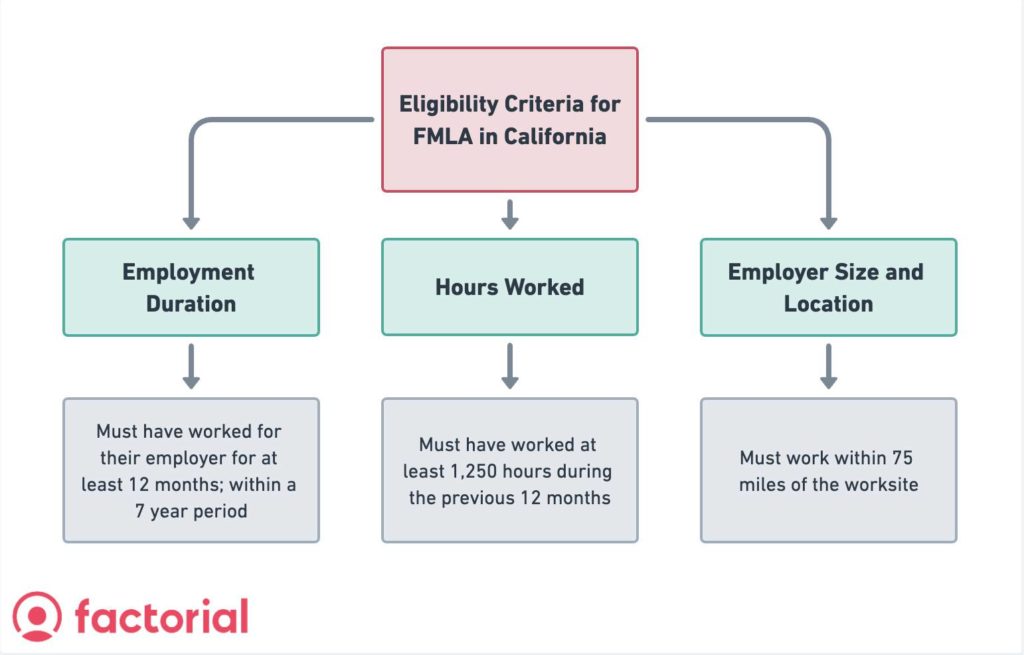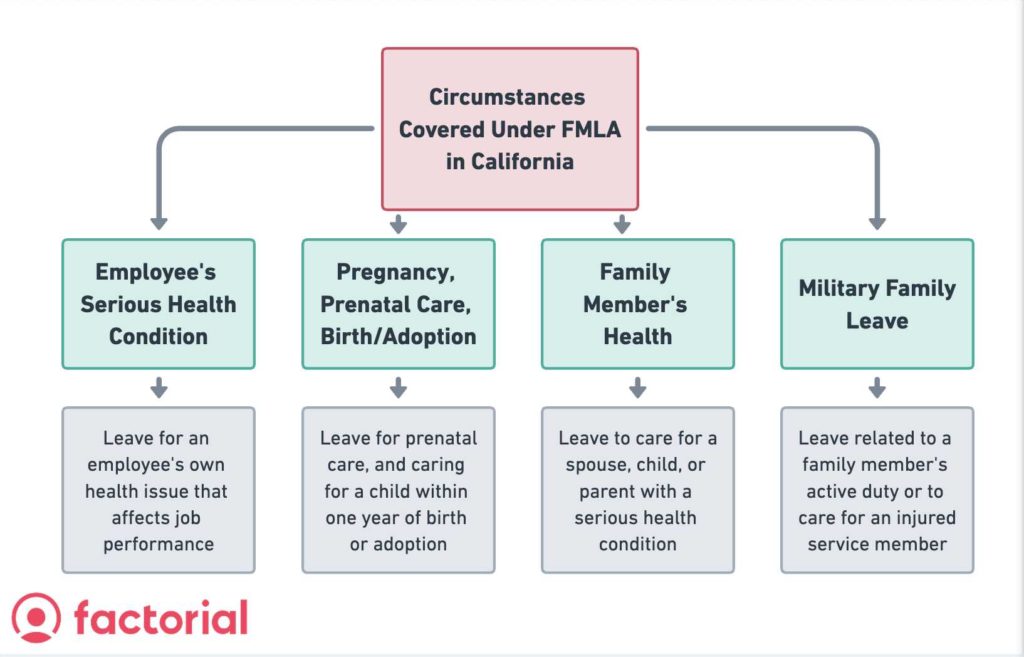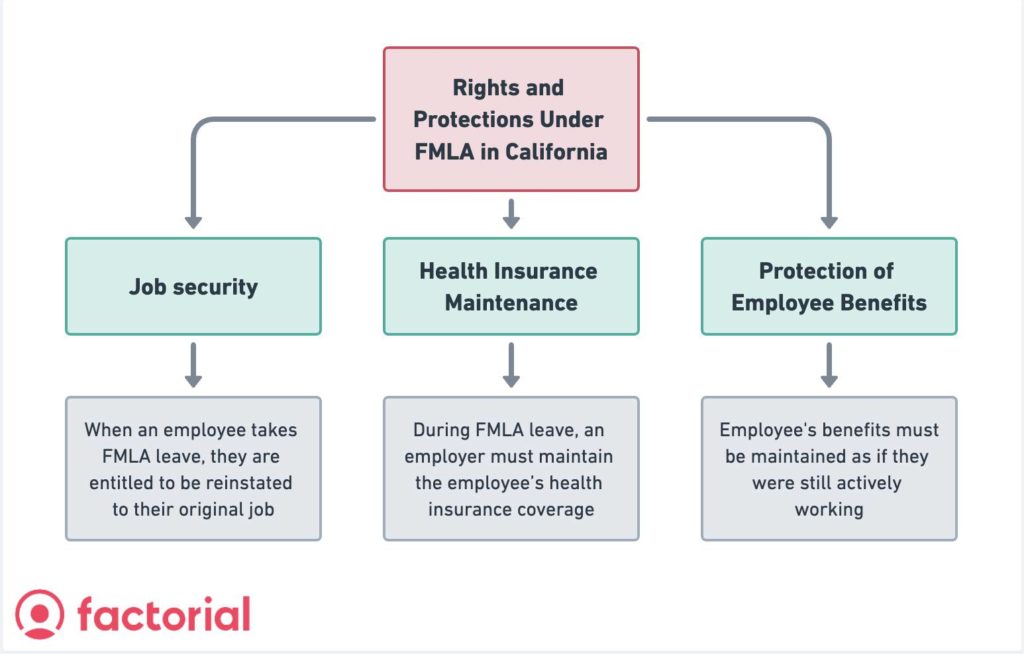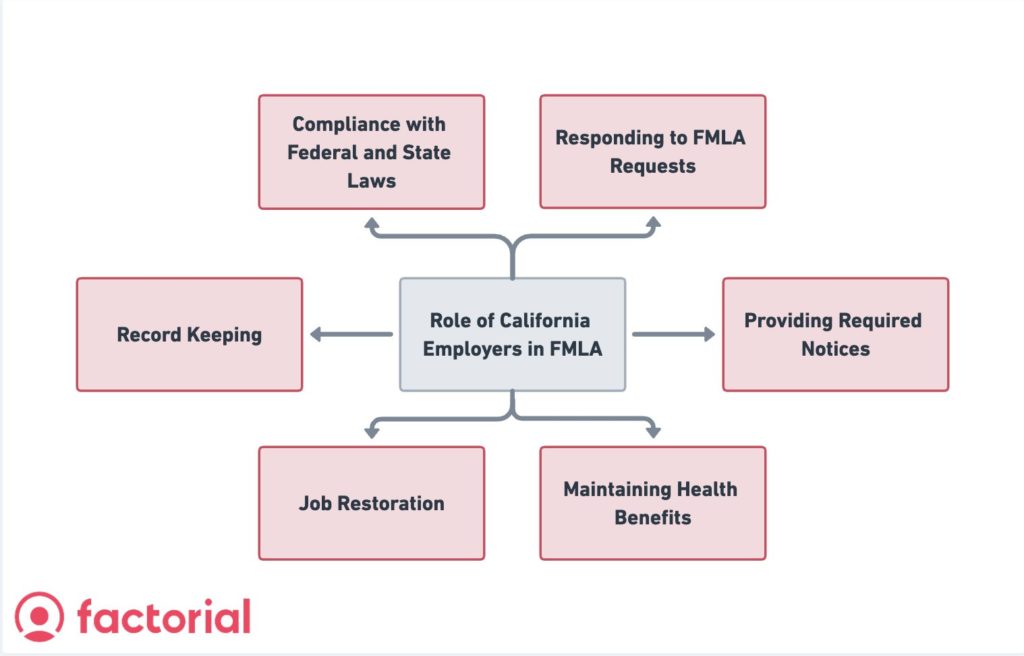It is one of the most important pieces of legislation in the country, especially in California, when it comes to employment rights and work-life balance. FMLA offers workers a safety net to help them balance work and personal life when they face health or family emergencies. It protects employees from losing their jobs or health insurance when they take unpaid, job-protected leave.
Family Rights Act (CFRA) complements FMLA. CFRA tweaks FMLA provisions to better fit Californians’ needs and circumstances. In total, these acts create a framework that acknowledges and actively supports the fact that employees sometimes have to prioritize their health over work.
TABLE OF CONTENTS
- What is the Family and Medical Leave Act?
- Eligibility Criteria for FMLA in California
- Key Provisions of the FMLA/CFRA
- Reasons for Availing FMLA Leave
- Application Process for FMLA Leave
- Rights and Protections Under FMLA
- Role of California Employers in FMLA
- Resources and Assistance
- FAQ about Family and Medical Leave Act California
- Effortlessly Track Employee Time Off With This HR Software ✅
What is the Family and Medical Leave Act (FMLA) in California?
In the United States, the Family and Medical Leave Act (FMLA) is a cornerstone of employee rights and workplace flexibility. FMLA was enacted in 1993 to help employees balance work and personal health needs, while also ensuring the economic security and stability of families during medical crises or major life events.
Employees with an eligible FMLA can take up to 12 weeks of unpaid, job-protected leave annually. Employees can take advantage of this leave for a variety of medical or family reasons, including birthing or adopting a child, caring for a family member with a serious health condition, or taking care of their own serious health condition.
Depending on the circumstances, the FMLA may extend this leave up to 26 weeks in a 12-month period when caring for a covered service member.
Eligibility Criteria for FMLA in California
Employers and employees must understand who qualifies for the Family and Medical Leave Act (FMLA), which sets specific eligibility criteria. With these criteria, employers can maintain a fair, manageable system while providing FMLA benefits to those who need them.

- Employment Duration: One of the primary criteria for FMLA eligibility is the duration of employment with the current employer. An employee must have worked for their employer for at least 12 months. However, these 12 months need not be consecutive. This means that any previous periods of employment with the same employer can potentially count towards this 12-month requirement, provided the break in service does not exceed seven years.
- Hours Worked: In addition to the duration of employment, the number of hours worked is a critical factor. An employee must have worked at least 1,250 hours during the 12 months immediately preceding the start of the FMLA leave. This requirement translates to an average of just over 24 hours per week over a year. Part-time workers who meet this hours threshold are just as eligible as full-time employees, emphasizing the FMLA’s inclusive approach.
- Employer Size and Location: The FMLA applies to all public agencies, all public and private elementary and secondary schools, and companies with 50 or more employees. These employees must work within 75 miles of the worksite. This criterion ensures that the FMLA covers a significant portion of the workforce while considering the operational capacities of smaller businesses.
The California Family Rights Act (CFRA) complements these federal requirements by adding some state-specific protections and provisions to the FMLA.
Key Provisions of the FMLA/CFRA
Providing essential rights to employees in the United States, especially in California, is the mission of the Family and Medical Leave Act (FMLA) and the California Family Rights Act (CFRA). To understand how these acts operate and benefit employees, you must understand the following key provisions:
- Duration of Leave: One of the most significant provisions of the FMLA and CFRA is the duration of the leave they offer. Eligible employees are entitled to up to 12 workweeks of unpaid leave within a 12-month period. This provision is designed to provide sufficient time for employees to address their own serious health conditions, care for a family member with a serious health condition, bond with a new child, or handle exigencies related to a family member’s military service.
- Special Leave Entitlement for Military Families: The FMLA includes a special leave entitlement that is particularly relevant for families of servicemen and women. This provision allows eligible employees to take up to 26 workweeks of leave in a single 12-month period to care for a covered serviceman with a serious injury or illness. This extended leave recognizes the unique challenges and sacrifices faced by military families and provides them with additional support.
- Job Protection: A cornerstone of both the FMLA and CFRA is the job protection they offer. During FMLA/CFRA leave, an employee’s job is protected, meaning they must be reinstated to the same or an equivalent position upon their return to work. This protection is crucial as it ensures that employees do not have to choose between their health (or the health of their family members) and their job security. It also includes the continuation of group health insurance coverage under the same terms and conditions as if the employee had not taken leave.
As a result of these provisions, employees don’t have to choose between their health and family responsibilities and their livelihood. In California and across the country, the FMLA and CFRA help foster a more humane and supportive work environment by offering both time and job security.
Reasons for Availing FMLA Leave IN California
The Family and Medical Leave Act (FMLA) provides eligible employees with the opportunity to take leave for several significant life events and health-related reasons. Understanding these reasons is crucial for employees to effectively utilize their FMLA rights. Here are the primary reasons for availing FMLA leave:

- Care for a New Child: FMLA leave can be used for the birth of an employee’s child and to care for the newborn within one year of birth. It also applies to the adoption or foster care placement of a child with the employee, covering the first year after the placement.
- Incapacity due to Pregnancy, or Prenatal Medical Care: Employees can use FMLA leave for incapacity due to pregnancy or for prenatal care. This also includes any period of incapacity due to childbirth and any subsequent recovery period.
- Care for a Family Member with a Serious Health Condition: FMLA leave allows employees to care for a spouse, child, or parent who has a serious health condition. This provision is vital for employees needing to provide essential care and support to their immediate family members during critical times.
- Employee’s Own Serious Health Condition: Employees can take FMLA leave when they are unable to work due to their own serious health condition. This ensures that employees can focus on their health and recovery without the stress of job insecurity.
- Exigencies Related to a Family Member’s Active Military Duty: FMLA leave includes provisions for employees with family members on active military duty. This can include various exigencies such as attending military ceremonies, arranging for alternative childcare, addressing financial and legal arrangements, and spending time with a military member on short-term, temporary rest and recuperation leave during deployment.
Application Process for FMLA Leave in California
Applying for leave under the Family and Medical Leave Act (FMLA) involves a series of steps that both employees and employers need to follow. Understanding this process is crucial for a smooth and compliant experience. Here are the key steps in the application process for FMLA leave:
- Employee Notification:
- The first step is for the employee to notify their employer of their need for FMLA leave.
- If the leave is foreseeable, such as in the case of planned medical treatment or childbirth, the employee should provide at least 30 days’ notice.
- If the leave is unforeseeable, the employee must inform the employer as soon as practicable, typically the same or next business day.
- Employer Response:
- Upon receiving a leave request, the employer must provide a response within five business days.
- This response should include whether the employee is eligible for FMLA leave and any additional information required, such as a medical certification.
- Providing Documentation:
- Depending on the reason for the FMLA leave, the employee may need to provide documentation to support their request.
- This could include a medical certification from a healthcare provider for leaves related to serious health conditions.
- The employer must allow at least 15 calendar days for the employee to submit the required documentation.
- Employer Decision:
- Once the necessary documentation is provided, the employer must inform the employee whether the leave is approved as FMLA leave.
- This communication should be in writing and include details such as the amount of leave counted against the employee’s FMLA entitlement.
- Taking the Leave:
- After approval, the employee can commence their FMLA leave.
- FMLA leave can be continuous, intermittent, or on a reduced schedule, depending on the situation and with the employer’s agreement.
- Maintaining Benefits:
- During FMLA leave, an employee’s job and health insurance benefits are protected.
- Employers must maintain the employee’s health coverage under the same conditions as if they had continued to work.
- Return to Work:
- At the end of the FMLA leave, the employee is typically entitled to return to their original job or an equivalent position with equivalent pay, benefits, and other employment terms.
- The employer may require a fitness-for-duty certification for leaves related to the employee’s own serious health condition.
- Communication:
- Throughout the FMLA leave process, clear communication between the employee and employer is essential.
- Employees should keep their employers updated on their status and intention to return to work, while employers should clearly communicate any requirements or changes in policy.
Understanding and following these steps ensure that the FMLA leave is handled effectively and in compliance with the law, providing the necessary support for employees during critical times while maintaining clear and fair practices for employers.
Rights and Protections Under FMLA in California

The Family and Medical Leave Act (FMLA) provides employees with several key rights and protections that are crucial to understand. These protections are designed to ensure that employees can take necessary leave without fear of losing their job or health insurance benefits. Here are the primary rights and protections under the FMLA:
- Job Protection During and After FMLA Leave:
- One of the most significant protections under the FMLA is job security. When an employee takes FMLA leave, they are entitled to be reinstated to their original job or to an equivalent job with equivalent pay, benefits, and other terms and conditions of employment upon their return.
- This protection means that employees cannot be demoted, receive reduced pay, or lose seniority or other employee benefits because they took FMLA leave.
- Additionally, the FMLA protects employees from retaliation by their employers for exercising their rights under the Act. This includes protection from being fired, disciplined, or discriminated against for taking FMLA leave.
- Health Insurance Maintenance During Leave:
- During FMLA leave, an employer must maintain the employee’s health insurance coverage under any group health plan on the same terms as if the employee had continued to work.
- This means that if the employee had family or individual health insurance coverage through their employer before taking leave, they are entitled to keep this coverage during their FMLA leave.
- The employee remains responsible for any normal contributions to their health insurance premiums. If the employee’s portion of the premium is deducted from their paycheck, arrangements may need to be made to continue these payments during the leave period.
- Protection of Employee Benefits:
- While on FMLA leave, an employee’s benefits, such as life insurance, disability insurance, sick leave, annual leave, or pension/retirement plans, must be maintained as if they were still actively working.
- However, the FMLA does not require the employer to allow the accrual of additional benefits or seniority during the period of leave.
Role of California Employers in FMLA
The Family and Medical Leave Act (FMLA) places significant responsibilities on employers, requiring them to adhere to specific regulations and procedures to ensure compliance with both federal and state laws. Understanding these responsibilities is crucial for employers to effectively manage FMLA leave requests and maintain a lawful and supportive workplace. Here are the key aspects of the employer’s role in FMLA:

- Recognizing and Responding to FMLA Requests:
- Employers are responsible for recognizing when an employee’s leave request may be eligible for FMLA protection and for informing the employee of their rights under the FMLA.
- This includes providing timely responses to leave requests, typically within five business days, and notifying employees of their eligibility for FMLA leave.
- Providing Required Notices:
- Employers must display an informative poster summarizing the major provisions of the FMLA and how to file a complaint. This poster must be displayed prominently where it can be readily seen by employees and applicants.
- Additionally, employers are required to provide employees with a written notice detailing specific expectations and obligations of the FMLA leave, including any requirement to provide a medical certification and the consequences of failing to do so.
- Maintaining Health Benefits:
- During FMLA leave, employers must maintain the employee’s group health insurance coverage under the same terms and conditions as if the employee had not taken leave.
- Employers must also ensure that employees are reinstated to their benefits upon their return from FMLA leave.
- Job Restoration:
- Upon an employee’s return from FMLA leave, employers are obligated to restore the employee to the same or an equivalent position with equivalent pay, benefits, and other terms of employment.
- Record Keeping:
- Employers must keep accurate records of FMLA leaves, including dates of FMLA leave taken by employees, copies of FMLA notices given to employees, documents describing employee benefits, and any disputes regarding the designation of leave as FMLA leave.
- Compliance with Federal and State Laws:
- Employers must comply with both the federal FMLA regulations and any applicable state laws, such as the California Family Rights Act (CFRA), which may provide additional protections or requirements.
- This includes understanding the nuances between federal and state regulations and applying the most generous provisions to the employee.
Resources for the Family and Medical Leave Act Laws in California
Navigating the Family and Medical Leave Act (FMLA) and understanding your rights and responsibilities can be complex. Fortunately, there are several resources and avenues for assistance available to both employees and employers. Here’s where you can find more information and get assistance:
- U.S. Department of Labor (DOL):
- The DOL’s Wage and Hour Division is responsible for administering and enforcing the FMLA for most employees.
- Their website provides comprehensive information, including fact sheets, FAQs, and detailed guides about FMLA.
- Contact Information:
- Website: U.S. Department of Labor – FMLA
- Phone: 1-866-4US-WAGE (1-866-487-9243)
- California Department of Fair Employment and Housing (DFEH):
- For California residents, the DFEH is a key resource for information on the California Family Rights Act (CFRA), which runs parallel to the FMLA.
- The DFEH website offers guides, FAQs, and resources specific to California’s laws and regulations.
- Contact Information:
- Website: California Department of Fair Employment and Housing
- Phone: 1-800-884-1684 (California only) or 1-916-478-7251 (Outside California)
- Employer Resources:
- Employers often provide resources and information about FMLA through human resources departments. They can assist with the application process, explain company-specific policies, and provide necessary forms and documentation.
- Legal Assistance:
- For legal advice or if you believe your rights under the FMLA have been violated, consulting an attorney specializing in labor law can be beneficial.
- The American Bar Association offers a lawyer referral service, and many states have their own legal aid organizations.
- Employee Assistance Programs (EAPs):
- Many organizations offer EAPs that provide confidential support, resources, and counseling on a variety of topics, including navigating FMLA leave.
FMLA per State
- Family and Medical Leave Act Florida: How Does It Work?
- Family and Medical Leave Act Texas: How Does It Work?
- Family and Medical Leave Act Illinois: How Does It Work?
- Family and Medical Leave Act Colorado: How Does It Work?
- Family and Medical Leave Act Ohio: How Does It Work?
- Family and Medical Leave Act Massachusetts: How Does It Work?
- Family and Medical Leave Act NY: How Does It Work?
- Family and Medical Leave Act Oregon: How Does It Work?
- Family and Medical Leave Act Michigan: How Does It Work?
- Family and Medical Leave Act Georgia: How Does It Work?
- Family and Medical Leave Act Indiana: How Does It Work?
- Family and Medical Leave Act Maryland: How Does It Work?
- Family and Medical Leave Act Missouri: How Does It Work?
- Family and Medical Leave Act Nevada: How Does It Work?
- Family and Medical Leave Act New Jersey: How Does It Work?
Here are other important articles related to California:
- Overtime Pay California Law 2024: Guide for Employers and Employees
- California WARN Act: HR Guide for Employers
- California Minimum Wage: Comprehensive Guide
- California state holidays: An employer’s guide
- CPRA vs CCPA: What are California’s privacy laws?
- California Privacy Rights Act (CPRA): Guide for employers
- California Family Rights Act (CFRA): Complete guide for HR
- Navigating California Bereavement Leave in 2023
- What the California Pay Transparency Law 2023 means for you
- California Employment Laws: HR Guide
FAQ about Family and Medical Leave Act California
The Family and Medical Leave Act (FMLA) is a crucial law for employees, but it often comes with a host of questions and misconceptions. Addressing these misunderstandings is important for both employees and employers to ensure that the FMLA is utilized correctly and effectively. Here are some common questions and misconceptions about FMLA leave:
1. Is FMLA Leave Paid or Unpaid in California?
One of the most common misconceptions about FMLA leave is that it is paid leave. In reality, FMLA provides for unpaid leave. However, employees may choose or employers may require the use of accrued paid leave (like vacation or sick leave) to cover some or all of the FMLA leave period. Some states or employers may establish their own policies or programs that provide paid leave, allowing employees to use them alongside FMLA leave.
2. Does FMLA Apply to All Employers in California?
Another common misunderstanding is that FMLA applies to all employers. In fact, FMLA applies to all public agencies, including state, local, and federal employers, and private sector employers who have 50 or more employees. These employees must be employed within 75 miles of the worksite.
3. Can FMLA Leave Be Taken Intermittently in California?
Many employees are unaware that FMLA leave can be taken intermittently or on a reduced schedule basis in certain circumstances. This is particularly relevant for ongoing medical treatments or situations where the employee or their family member has a serious health condition that requires periodic care.
4. Are All Employees Eligible for FMLA Leave in California?
Not all employees are eligible for FMLA leave. Employees are eligible if they have worked for their employer for at least 12 months, have at least 1,250 hours of service in the 12 months before taking leave, and work at a location where the employer has at least 50 employees within 75 miles.
5. Does FMLA Leave Affect Employee Benefits in California?
There’s a misconception that taking FMLA leave will result in the loss of employee benefits. In reality, while FMLA leave is unpaid, the employer must maintain the employee’s health benefits under the same conditions as if they were working. Other benefits, such as seniority or paid leave accrual, may not necessarily continue to accrue during the period of FMLA leave.
6. Can an Employer Refuse FMLA Leave in California?
Employers cannot refuse FMLA leave if the employee is eligible and the leave qualifies under the FMLA. However, employers can request appropriate documentation, such as medical certification, to support the need for leave.
7. Is Every Medical Condition Covered Under FMLA in California?
Not every medical condition qualifies for FMLA leave. The FMLA covers serious health conditions, which are defined as illnesses, injuries, impairments, or physical or mental conditions that involve inpatient care or continuing treatment by a healthcare provider.
If you have any questions, please leave a comment here, and our HR Specialist will respond as soon as possible.


